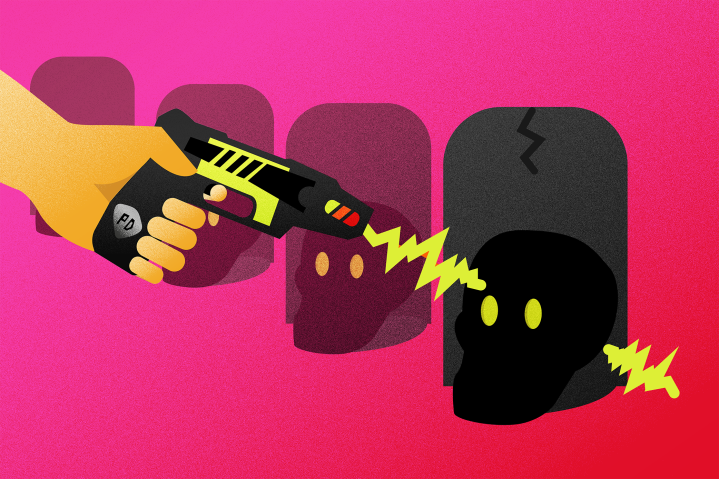
The ongoing debate over defunding police departments has prompted many communities to rethink the role of police officers and even consider diverting some of their responsibilities to professionals with more appropriate training. But there’s an easy policy fix that could serve to eliminate one specific line-item in just about every police department’s budget in the country: Ban the Taser.
There’s no better representation of the failure of police reform — and the intransigence of the police industrial complex — than the fact that cops in nearly every police department in the U.S. have Tasers strapped to their belts. The death of Rayshard Brooks, and the degeneration of the debate over whether “non-lethal” Tasers can kill, shows us why.
Here’s a quick history of the supposedly less-than-lethal weapon: In the late 1960s, aircraft company executive Jack Cover dreamed up the Taser and spent a decade failing to sell it to law enforcement. Then came the tragedy of Eula Love: In 1979, officers with the Los Angeles Police Department killed a Black woman who threw a kitchen knife in their direction. Protests followed, along with calls for reform.
Los Angeles city leaders theorized that, if cops had a “non-lethal” alternative to a firearm, they would have subdued Love instead of killing her. No research indicated this might be true. No case studies bolstered this theory. But LAPD brass went forward anyway with a contract to buy Tasers from Mr. Cover and the company he ran — the only company in the world that sold them.
What gets lost in this history is that, before LAPD leaders signed that contract, they went to Cover with a request: They wanted the Taser, but, first, it needed to be stronger; it needed to pack a more violent electric shock.
Cover had been careful about the power of the initial Taser designs; he knew it ran the risk of electrocuting people — killing them — and he was careful to make it strong enough to stop a suspect but not kill them.
When officials inside LAPD asked for a stronger electric shock, they essentially asked Cover to ignore any nuance he’d applied to his initial design.
Cover — who, according to a former colleague, had political beliefs “to the right of Attila the Hun” — obliged. He risked making his non-lethal weapon deadly. And he went forward anyway, to seal the lucrative deal.
“At a cost of more than $1,000 per weapon, plus the price of replacement cartridges, police departments spend an unbelievable amount of money on Tasers.”
Within months of a department-wide rollout of Tasers in the LAPD, cases began to emerge in which people who were shocked by Tasers ended up dead: Vincent Alvarez in August 1983. Raul Guevara in January 1984. Then Larry Gardner, Cornelius Smith, Lannie McCoy. Many others. And when the LAPD contract went forward, other police departments followed suit — and more deaths started to occur.
But this truth — that people were being shocked to death by Taser-wielding cops — conflicted with the whole premise that drew police and Los Angeles’ city leaders to the weapon in the first place: That it was a non-lethal alternative to firearms.
Regardless, that premise — a false one — propelled the Taser into more and more police departments. Cover would eventually retire and sell the rights to his Taser patents to various increasingly successful companies, and eventually put Tasers into the hands of officers in just about every one of the 18,000 independent police agencies in the U.S.
It was only in late 2013 that the current patent-holder of the Taser design, the publicly-traded company, Axon Enterprise, had to admit in court that, yes, its weapons could kill. Its leaders had argued for years that its weapons were “non-lethal.”

My book, Thin Blue Lie: The Failure of High-Tech Policing, goes into exhaustive detail about the rest of the Taser’s history, and how it has been used for decades as a placeholder for real policing reform.
Now, with the death of Rayshard Brooks, this history of mixed messaging about the Taser’s safety and usefulness is closing in on itself.
Boiling that sad case — and Brooks’ tragic, unnecessary death — down to its most basic facts is difficult. But, for this discussion, here’s what’s important: Brooks fell asleep in a fast-food drive-through and interacted nonviolently with Atlanta police. When those officers tried to handcuff and arrest Brooks on DUI-related charges, he grabbed former officer Garrett Rolfe’s Taser and, according to Rolfe’s account, tried to fire it at him. Rolfe — perhaps knowing that Georgia law designates the Taser as a lethal weapon — took that as a cue to shoot and kill Brooks. Rolfe has been charged with felony murder, and the union representing him says the shooting was justified because Tasers are lethal.
That’s a big deal. For decades, lawyers for Axon Enterprise (under the company’s previous corporate moniker, Taser International) — along with police and union leaders nationwide — have argued that it’s not.
“… not only did the weapon fail to subdue him, but it also acted as the basis to escalate an interaction to deadly force. It failed in both circumstances that it could’ve possibly been useful.”
The origin of the Taser’s use in police departments is inextricably tied to the premise that they are a non-lethal tool for de-escalation. City leaders in Los Angeles made the decision to try them forty years ago for that reason, and virtually every contract to purchase Tasers since then has been built around the same idea. If instead, in cases like Brooks’ which is not unique, they lead to death and chaos, then what is the point?
At a cost of more than $1,000 per weapon plus the price of replacement cartridges, which add significant cost to provide the ammunition for each individual stun, police departments spend an unbelievable amount of money on these weapons. In the first three months of 2020 alone, Axon Enterprise reported more than $68 million in sales on its Taser-related products, not including warranties. The vast majority of those dollars come from taxpayers buying Taser products for police. That doesn’t even get into the hundreds of millions of dollars that police departments pay in civil litigation related to maleficent Taser use by cops. Or the documented corruption that has been tied to contracts that police departments have signed with the company that sells them.

Even that company has moved away from branding itself as having a monopoly on Tasers: Axon Enterprise’s sales were once exclusively sourced from Taser products. Now, nearly half of its sales come from body cameras and related services such as camera accessories and storage. That’s a strong shift that went along with the company’s decision to change its name from Taser International to Axon Enterprise in 2017 — precisely because it didn’t want to be known as only a Taser manufacturer.
It’s time to end the Taser charade. In Rayshard Brooks’ killing, not only did the weapon fail to subdue him, but it also acted as the basis to escalate an interaction to deadly force. It failed in both circumstances that it could’ve possibly been useful.
As we consider how policing should change after Brooks’ death — and the deaths of George Floyd, Breonna Taylor, Ahmaud Arbery, and many others — one question is: How can police leaders continue to spend taxpayer money on Tasers? They’re anathema to real reform. Stop spending taxpayer dollars on them.
Ban the Taser.
Editors' Recommendations
- Moore’s law is reaching its limits. Could graphene circuits help?
- Terrifying Clearview app could be the end of anonymity in public places



